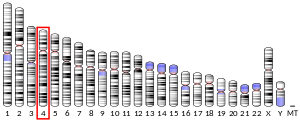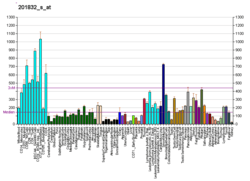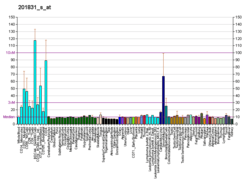USO1
General vesicular transport factor p115 is a protein that in humans is encoded by the USO1 gene.[5][6][7][8][9][10]
Function
The protein encoded by this gene is a peripheral membrane protein which recycles between the cytosol and the Golgi apparatus during interphase. It is regulated by phosphorylation: dephosphorylated protein associates with the Golgi membrane and dissociates from the membrane upon phosphorylation. Ras-associated protein 1 recruits this protein to coat protein complex II (COPII) vesicles during budding from the endoplasmic reticulum (ER), where it interacts with a set of COPII vesicle-associated SNAREs to form a cis-SNARE complex that promotes targeting to the Golgi apparatus. Transport from the ER to the cis/medial Golgi compartments requires the action of this gene product, GOLGA2, and giantin in a sequential manner.[10]
Interactions
USO1 has been shown to interact with:
References
- GRCh38: Ensembl release 89: ENSG00000138768 - Ensembl, May 2017
- GRCm38: Ensembl release 89: ENSMUSG00000029407 - Ensembl, May 2017
- "Human PubMed Reference:". National Center for Biotechnology Information, U.S. National Library of Medicine.
- "Mouse PubMed Reference:". National Center for Biotechnology Information, U.S. National Library of Medicine.
- Sohda M, Misumi Y, Yano A, Takami N, Ikehara Y (March 1998). "Phosphorylation of the vesicle docking protein p115 regulates its association with the Golgi membrane". J Biol Chem. 273 (9): 5385–8. doi:10.1074/jbc.273.9.5385. PMID 9478999.
- Nakamura N, Lowe M, Levine TP, Rabouille C, Warren G (June 1997). "The vesicle docking protein p115 binds GM130, a cis-Golgi matrix protein, in a mitotically regulated manner". Cell. 89 (3): 445–55. doi:10.1016/S0092-8674(00)80225-1. PMID 9150144.
- Whyte JR, Munro S (June 2002). "Vesicle tethering complexes in membrane traffic". J Cell Sci. 115 (Pt 13): 2627–37. PMID 12077354.
- Short B, Haas A, Barr FA (June 2005). "Golgins and GTPases, giving identity and structure to the Golgi apparatus". Biochim Biophys Acta. 1744 (3): 383–95. doi:10.1016/j.bbamcr.2005.02.001. PMID 15979508.
- Puthenveedu MA, Linstedt AD (February 2004). "Gene replacement reveals that p115/SNARE interactions are essential for Golgi biogenesis". Proc Natl Acad Sci U S A. 101 (5): 1253–6. doi:10.1073/pnas.0306373101. PMC 337039. PMID 14736916.
- "Entrez Gene: VDP vesicle docking protein p115".
- Shorter J, Beard MB, Seemann J, Dirac-Svejstrup AB, Warren G (April 2002). "Sequential tethering of Golgins and catalysis of SNAREpin assembly by the vesicle-tethering protein p115". J. Cell Biol. 157 (1): 45–62. doi:10.1083/jcb.200112127. PMC 2173270. PMID 11927603.
- Allan BB, Moyer BD, Balch WE (July 2000). "Rab1 recruitment of p115 into a cis-SNARE complex: programming budding COPII vesicles for fusion". Science. 289 (5478): 444–8. doi:10.1126/science.289.5478.444. PMID 10903204.
Further reading
- Waters MG, Clary DO, Rothman JE (1992). "A novel 115-kD peripheral membrane protein is required for intercisternal transport in the Golgi stack". J. Cell Biol. 118 (5): 1015–26. doi:10.1083/jcb.118.5.1015. PMC 2289595. PMID 1512287.
- Barr FA, Nakamura N, Warren G (1998). "Mapping the interaction between GRASP65 and GM130, components of a protein complex involved in the stacking of Golgi cisternae". EMBO J. 17 (12): 3258–68. doi:10.1093/emboj/17.12.3258. PMC 1170664. PMID 9628863.
- Nelson DS, Alvarez C, Gao YS, García-Mata R, Fialkowski E, Sztul E (1998). "The membrane transport factor TAP/p115 cycles between the Golgi and earlier secretory compartments and contains distinct domains required for its localization and function". J. Cell Biol. 143 (2): 319–31. doi:10.1083/jcb.143.2.319. PMC 2132831. PMID 9786945.
- Allan BB, Moyer BD, Balch WE (2000). "Rab1 recruitment of p115 into a cis-SNARE complex: programming budding COPII vesicles for fusion". Science. 289 (5478): 444–8. doi:10.1126/science.289.5478.444. PMID 10903204.
- Dirac-Svejstrup AB, Shorter J, Waters MG, Warren G (2000). "Phosphorylation of the vesicle-tethering protein p115 by a casein kinase II-like enzyme is required for Golgi reassembly from isolated mitotic fragments". J. Cell Biol. 150 (3): 475–88. doi:10.1083/jcb.150.3.475. PMC 2175190. PMID 10931861.
- Alvarez C, Garcia-Mata R, Hauri HP, Sztul E (2001). "The p115-interactive proteins GM130 and giantin participate in endoplasmic reticulum-Golgi traffic". J. Biol. Chem. 276 (4): 2693–700. doi:10.1074/jbc.M007957200. PMID 11035033.
- Hartley JL, Temple GF, Brasch MA (2001). "DNA cloning using in vitro site-specific recombination". Genome Res. 10 (11): 1788–95. doi:10.1101/gr.143000. PMC 310948. PMID 11076863.
- Wiemann S, Weil B, Wellenreuther R, Gassenhuber J, Glassl S, Ansorge W, Böcher M, Blöcker H, Bauersachs S, Blum H, Lauber J, Düsterhöft A, Beyer A, Köhrer K, Strack N, Mewes HW, Ottenwälder B, Obermaier B, Tampe J, Heubner D, Wambutt R, Korn B, Klein M, Poustka A (2001). "Toward a catalog of human genes and proteins: sequencing and analysis of 500 novel complete protein coding human cDNAs". Genome Res. 11 (3): 422–35. doi:10.1101/gr.GR1547R. PMC 311072. PMID 11230166.
- Brunati AM, Marin O, Folda A, Meggio F, Pinna LA (2001). "Possible implication of the Golgi apparatus casein kinase in the phosphorylation of vesicle docking protein p115 Ser-940: a study with peptide substrates". Biochem. Biophys. Res. Commun. 284 (3): 817–22. doi:10.1006/bbrc.2001.5049. PMID 11396975.
- Shorter J, Beard MB, Seemann J, Dirac-Svejstrup AB, Warren G (2002). "Sequential tethering of Golgins and catalysis of SNAREpin assembly by the vesicle-tethering protein p115". J. Cell Biol. 157 (1): 45–62. doi:10.1083/jcb.200112127. PMC 2173270. PMID 11927603.
- Short B, Preisinger C, Schaletzky J, Kopajtich R, Barr FA (2003). "The Rab6 GTPase regulates recruitment of the dynactin complex to Golgi membranes". Curr. Biol. 12 (20): 1792–5. doi:10.1016/S0960-9822(02)01221-6. PMID 12401177.
- Chiu R, Novikov L, Mukherjee S, Shields D (2003). "A caspase cleavage fragment of p115 induces fragmentation of the Golgi apparatus and apoptosis". J. Cell Biol. 159 (4): 637–48. doi:10.1083/jcb.200208013. PMC 2173109. PMID 12438416.
- Han SJ, Lee JH, Kim CG, Hong SH (2003). "Identification of p115 as a PLCgamma1-binding protein and the role of Src homology domains of PLCgamma1 in the vesicular transport". Biochem. Biophys. Res. Commun. 300 (3): 649–55. doi:10.1016/S0006-291X(02)02884-X. PMID 12507498.
- García-Mata R, Sztul E (2003). "The membrane-tethering protein p115 interacts with GBF1, an ARF guanine-nucleotide-exchange factor". EMBO Rep. 4 (3): 320–5. doi:10.1038/sj.embor.embor762. PMC 1315890. PMID 12634853.





